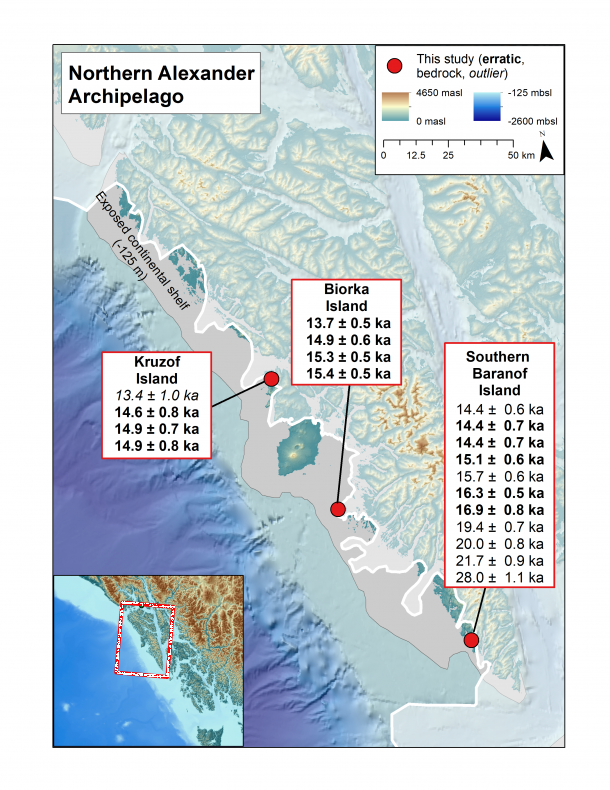The author(s) will give a talk
The hunt for ice-free areas along the coastal Cordilleran Ice Sheet margin during the LGM continues: No dice in the northern Alexander Archipelago
1 University at Buffalo
2 University at Buffalo
3 Tongass National Forest
The late Pleistocene history of the coastal Cordilleran Ice Sheet (CIS) remains relatively unstudied compared to the Laurentide (LIS) and Fennoscandian ice sheets (Dalton et al., 2020; Hughes et al., 2016). Yet accurate reconstructions of CIS extent and timing of ice retreat along the Pacific Coast are essential for a variety of reasons including paleoclimate modeling, assessing meltwater contribution to the North Pacific, and determining the timing and configuration of a coastal human migration route from Beringia into the Americas. This hypothesized “coastal route” relies on the availability of areas that were ice-free throughout the local Last Glacial Maximum (lLGM; 19 – 17 ka; Lesnek et al., 2018) or areas that deglaciated quickly after the lLGM along the coasts of SE Alaska (SEAK) and British Columbia.
We used Be-10 dating of glacial landforms (boulders and sculpted bedrock) to determine when the CIS retreated in the northern Alexander Archipelago, Alaska, and if areas were ice-free throughout the lLGM. Specifically, we targeted areas of the northern Alexander Archipelago that were mapped as ice-free in previous studies (Carrara et al., 2007). Our results show that these hypothesized areas of ice-free land were in fact covered by ice until 15.1 ± 0.9 ka (n = 12 boulders; 1 SD). This work builds off previous studies, and our chronology overlaps (within 1 SD) with their deglaciation date of 16.3 ± 0.8 ka (n = 13 boulders; 1 SD) in the southern Alexander Archipelago (Lesnek et al., 2020; Lesnek et al., 2018). Combined, these data provide a mean deglaciation age of 15.7 ± 1.0 ka (n = 25 boulders; 1 SD) along the coastal Alexander Archipelago., though there may be differences in the timing of deglaciation of different islands.
These results from the northern Alexander Archipelago indicate areas above modern sea-level that were previously-mapped as glacial refugia were covered by ice during the lLGM until ~15.1 ka. Previous ice-sheet reconstructions underestimate the regional maximum CIS extent, as ice likely terminated on the continental shelf. Furthermore, we are now increasingly confident that no areas currently above sea-level were ice-free throughout the lLGM, but it is still unknown whether presently submerged areas on the continental shelf were ice-free.
Carrara, P. E., Ager, T. A., and Baichtal, J. F., 2007, Possible refugia in the Alexander Archipelago of southeastern Alaska during the late Wisconsin glaciation: Canadian Journal of Earth Sciences, v. 44, no. 2, p. 229-244.
Dalton, A. S., Margold, M., Stokes, C. R., Tarasov, L., Dyke, A. S., Adams, R. S., Allard, S., Arends, H. E., Atkinson, N., and Attig, J. W., 2020, An updated radiocarbon-based ice margin chronology for the last deglaciation of the North American Ice Sheet Complex: Quaternary Science Reviews, v. 234, p. 106223.
Hughes, A. L. C., Gyllencreutz, R., Lohne, Ø. S., Mangerud, J., and Svendsen, J. I., 2016, The last Eurasian ice sheets–a chronological database and time?slice reconstruction, DATED?1: Boreas, v. 45, no. 1, p. 1-45.
Lesnek, A. J., Briner, J. P., Baichtal, J. F., and Lyles, A. S., 2020, New constraints on the last deglaciation of the Cordilleran Ice Sheet in coastal Southeast Alaska: Quaternary Research, v. 96, p. 140-160.
Lesnek, A. J., Briner, J. P., Lindqvist, C., Baichtal, J. F., and Heaton, T. H., 2018, Deglaciation of the Pacific coastal corridor directly preceded the human colonization of the Americas: Science Advances, v. 4, no. 5, p. eaar5040.

Fig 1.
Map of the study sites in the northern Alexander Archipelago, Alaska. Maximum ice limits after Lesnek et al. (2020). Extent of exposed continental shelf after Carrara et al. (2007).